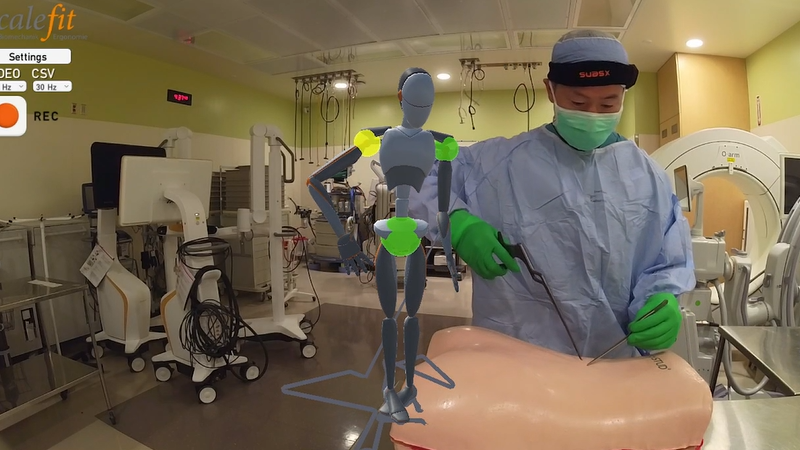Ergonomic analysis for spine surgeons: saving your back and neck
With Xsens MVN Analyze
This article was first published on
www.movella.comWith the majority of spine surgeons experiencing bodily discomfort due to their work, the need for ergonomic improvements in the healthcare industry is clear. Orthopedic spine surgeon Philip Louie is on a mission to address this issue, leveraging Xsens motion capture technology and Scalefit software to identify pain points and create solutions that enhance surgeons’ physical well-being and long-term performance.
Challenge: To effectively analyze surgeons’ occupational health and safety, healthcare professional Philip Louie needed an objective dataset to define specific problem areas.
Solution: Using the Xsens inertial motion capture and Scalefit software provided highly accurate data on the surgeons’ movements, all while maintaining privacy for themselves and their patients.
Key takeaways:
- Advanced data accuracy for ergonomic assessment: inertial motion capture records even the smallest movements, ensuring precise analysis
- Ensuring privacy: Camera-less technology guarantees anonymity for both patients and surgeons
- Authentic movement thanks to unobtrusive technology: comfortable wearables allow ergonomic professionals to track real, natural motion
An overwhelming 80% of spine surgeons experience bodily discomfort. This high proportion shows a need for occupational health and safety to be prioritized within the healthcare industry. Such injuries can lead to unexpected time off, declining performance, or even early retirement. Orthopedic spine surgeon Philip Louie is conducting a study to find out how to improve surgeons’ physical well-being to make their highly technical job that little bit easier.
Stopping spine surgeon injuries
“The majority of healthcare professionals experience some sort of bodily discomfort due to their job,” explains Philip. “So the first part of our study was to find the physical pain points of spine surgeons.” After completing a series of intense surgeries, Philip noticed the harmful impact and the role it had on his joints and muscles.
However, Philip was not the only surgeon experiencing these issues. He started the study to show that physical well-being is a profession-wide issue, not just a personal one, and with this information, hopes to build more ergonomically friendly surgery rooms. To effectively demonstrate his point, he needed objective data that put a spotlight on the exact areas for improvement in the healthcare industry.
Preparing for research
Philip decided to perform ergonomic analyses on three surgeons, each performing the same procedure ten times. “Using replicable surgeries as the basis for the study was crucial,” he says. “It allowed us to compare and contrast each dataset to identify outlying issues.” Philip then researched the different techniques for assessing occupational health and safety.
“For the first attempt, we used the REBA method,” explains Philip. REBA (rapid entire body analysis) requires an ergonomics analyst to manually assess the worker’s movements, using their knowledge of physical well-being to point out issues and suggest amendments. “We found that while this was useful, we didn’t have the quantitative, set-in-stone data needed for this project.”
An extra person in the surgery room also led to privacy issues for both patient and surgeon. Most would be uncomfortable having their work, or personal procedures, observed by a third party. Filming would also create an anonymity issue, leading to faces having to be blurred and time taken away from the investigation. After extensive research, Philip found the answer to anonymity while further improving the quality of data.
Using Xsens and Scalefit technology
“When we found inertial motion capture, we knew that it was the only way to efficiently carry out our research without encroaching on the privacy of others,” says Philip. Using inertial technology, the Xsens motion capture system tracks velocity, acceleration, and rotation without requiring any cameras. Instead, the data is sent directly from the wearables to post-processing software.
“I was able to perform a two-hour surgery while wearing the Xsens system,” Philip continues. “By the end, myself and the other surgeons forgot we were even wearing it.” The Awinda set contains 17 wireless sensors, all individually strapped to the body for bespoke comfort. The team could also maintain a sterile environment, with the sensors tucked underneath scrubs.
Using the Xsens motion data and Scalefit software, Philip could effectively collate his results to show objective findings, pinpointing the need for ergonomic improvement in the surgery room. The research team quantified this data to highlight the specific areas of a surgeon’s body that were most affected by their job. Having this abundance of data instantly available for research was essential for rapidly progressing the project.
Looking ahead
Ergonomic analysis is best carried out in a worker’s natural environment, doing the tasks they would do every day, and Xsens allows you to do just that. “I hope to roll out this technique to the rest of the healthcare industry,” says Philip. “Its usefulness was invaluable to us, and it can help many other professionals perform their jobs more safely.”
Philip’s research project is drawing to a close, and the last rounds of motion capture data are being recorded. He hopes to create tangible solutions for spine surgeons, with his ability to identify exact pain points and put together a plan to prevent them from happening, such as full-body exercises to relieve tension from the back, shoulders, wrists, and other vulnerable joints.
Just wearing the Xsens suit raised awareness for the toll surgery takes on medical professionals. Philip could see in real time how his body was reacting to holding it in a fixed position, encouraging him to relax and avoid experiencing unnecessary pain.
“Inertial motion capture technology was the only solution for this project,” concludes Philip. “Having this quantitative data is invaluable to our occupational health and safety.
